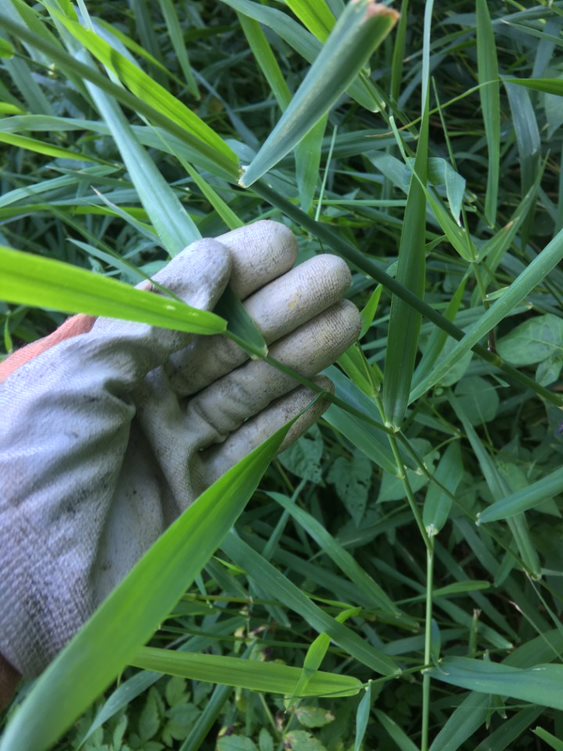Reed canarygrass identification and control
Information about the noxious weed reed canarygrass. Reed canarygrass is also known by its Latin name, Phalaris arundinacea.
About this weed
Reed canarygrass is a non-regulated Class C noxious weed. This means control is not required in King County under the state noxious weed law.
Reed canarygrass, known as Phalaris arundinacea, is in the grass family. Other common names for this plant are RCG, canary grass, canary reed grass, and ribbon grass.

Why it's a problem
Reed canarygrass grows in large, dense stands that outcompete native vegetation in wetland areas. It increases flooding by filling in creeks and ditches. It can also block migrating salmon when it fills in creeks.
It spreads by way of rhizomes, which are underground stems that grow outwards and then grow new stems. Reed canarygrass forms large, dense clones in this way. It also has aggressive roots that form a tight web of sod material that can get up to 1.5 feet thick.
When fields full of reed canarygrass flood, it can confuse and strand migrating salmon. Reed canarygrass can also cause indigestion in livestock.
Plant description
Reed canarygrass is a 3 to 6 feet tall perennial, cool season grass. It reproduces via seed and rhizomes (underground horizontally growing stems the form new shoots). It creates thick layers of dense grass roots, which is known as sod.
Its stem is hairless and hollow, often reddish near the top. In winter plants go dormant but the dead stems remain. This makes winter identification possible.
Leaves stick out at a 45-degree angle from the stem. Leaf blades are flat, hairless, bright green, and one-fourth to three-fourths inches wide. Leaves appear in early spring and die back in late fall.
Flowers, often mistaken for clusters of seeds, appear May to July. Flower heads are found in narrow clusters on the stems high above the leaves. The heads turn from green to purplish in full bloom, then straw colored when seeds form.
Reed canarygrass grows mostly in wet places or along creeks and lakes. However, it is hardy and can thrive anywhere it receives full sun and enough water.





Be aware of look-alike plants
There are many grasses that look like reed canarygrass. A good way to tell it apart from similar large grasses is by checking for the large membranous ligule.
Do this by gently pulling the leaf blade down and away from the stem. If it is reed canarygrass, there should be a clear papery part sticking out or laying where the leaf was pulled away.
Other grasses have this type of ligule, but if the grass also fits the rest of the description, and it is growing in a wet area, then it is likely to be reed canarygrass.
When in doubt, take photos and report them on iNaturalist.
What to do if you find it
Because reed canarygrass is so widespread, property owners in King County are not required to control it. We are not generally tracking infestations but we can provide advice on how to control reed canarygrass.
The King County Noxious Weed Control Board encourages property owners to remove reed canarygrass where possible. Owners are also encouraged to avoid introducing it to new landscapes.
Control methods
We recommend using a combination of methods to control weeds. In areas with few weeds, it is important to act quickly before they become harder to control. Make a long-term plan as it often takes several years to get rid of most weeds. Start in the least infested areas first and then move into more heavily infested areas.
Manual control
Hand pulling or digging is only practical for small patches. Be sure to remove the entire root mass. You can weaken reed canarygrass by covering it with tarps or heavy erosion-control fabric. However, this is unlikely to eliminate the infestation.
Cultural control
Reed canarygrass does not grow well in shade. A long-term solution is to establish a tree or tall shrub canopy. While the trees are growing, you will need to control the reed canarygrass. But once there is enough shade, this should keep the grass from returning.
Chemical control
Stay safe when using herbicide:
- Always read the label before use.
- Wear a long-sleeved shirt, long pants, shoes, and eye protection.
- Follow state and local regulations.
For eliminating larger patches, you will probably need herbicide treatments. See the PNW Pest Management Handbook for the most up to date and specific method for chemical control of reed canarygrass.
Avoid spraying where there is a chance that herbicide will enter a waterway or wetland unless you are using a state-approved aquatic herbicide and have the required permits and licenses to do so. Use of pesticides in water is regulated in Washington state. See Washington Department of Ecology Aquatic Pesticide Permits for details.
For more information or a site-specific recommendation in King County, contact the noxious weed program. For information in other locations, contact your local weed board or extension office.
Disposal instructions
Dispose root systems (rhizomes), plants in seed, and sod in a landfill (garbage). Because of this, it may not be practical to use manual removal to control large infestations.
You can discard stems without seeds in yard waste bins or take the material to a municipal composting facility.
Plant parts will generally form roots if left in contact with damp soil, so be sure to dry plants thoroughly if composting on site.
Noxious Weed Disposal - Washington State Noxious Weed Control Board

 Translate
Translate